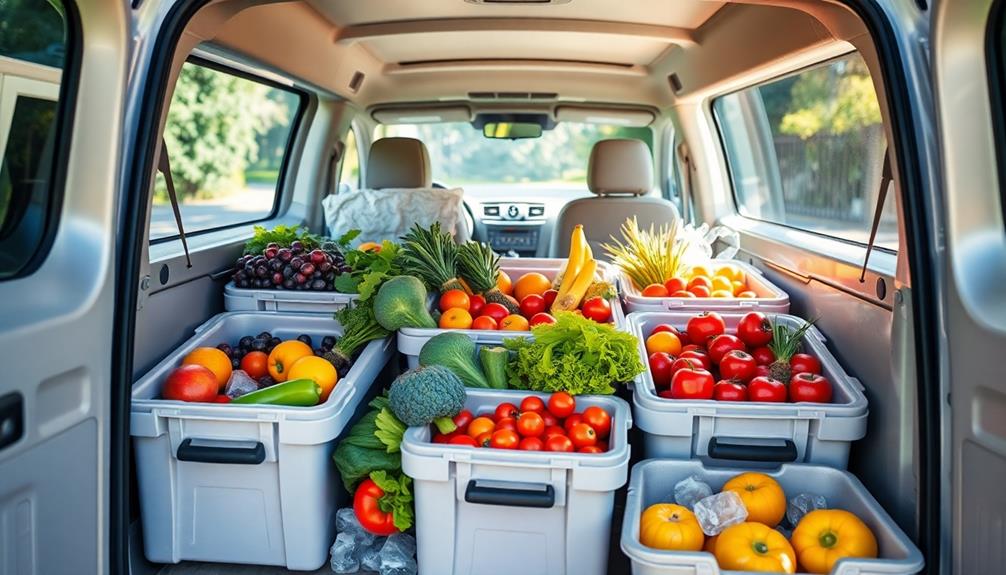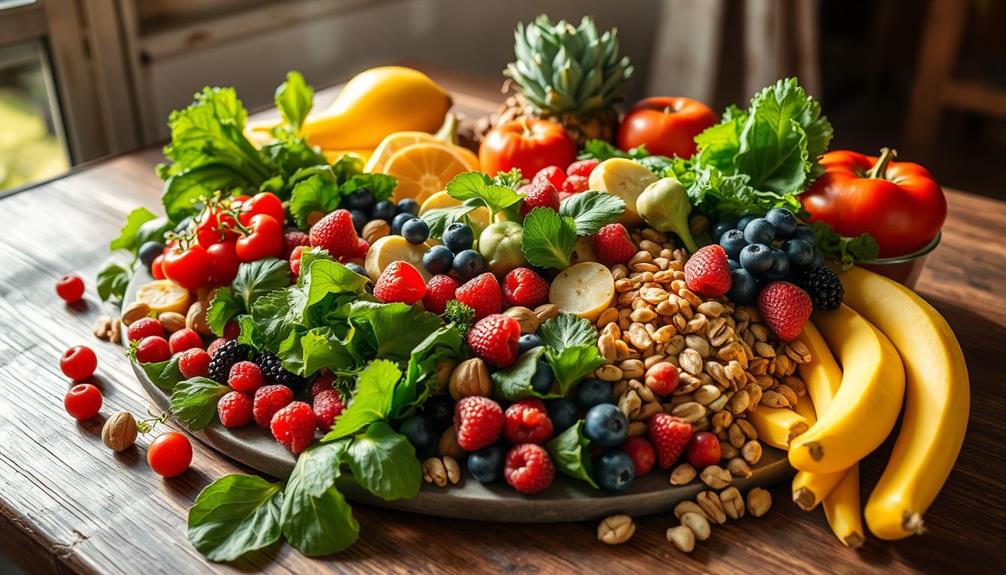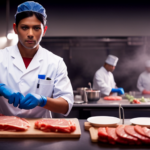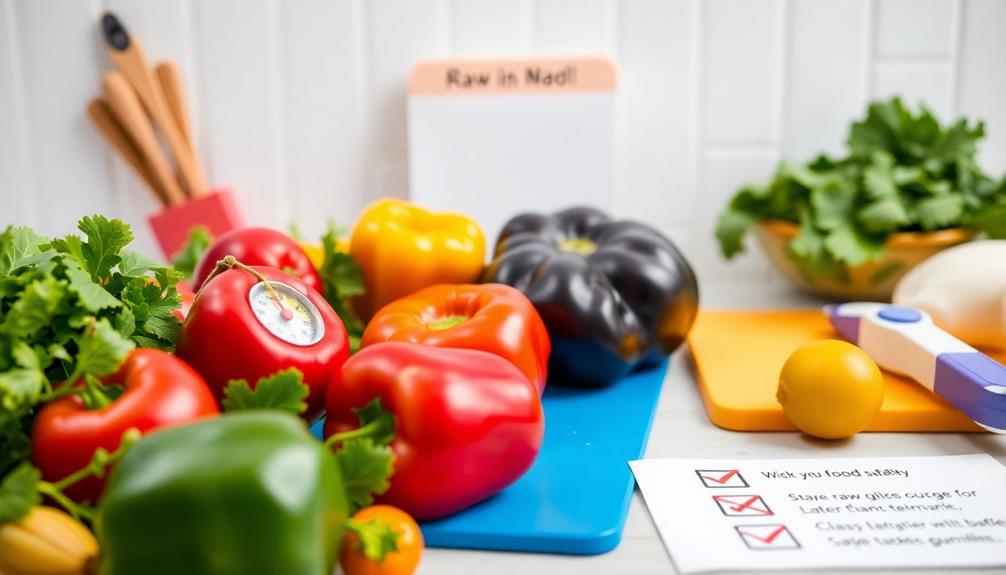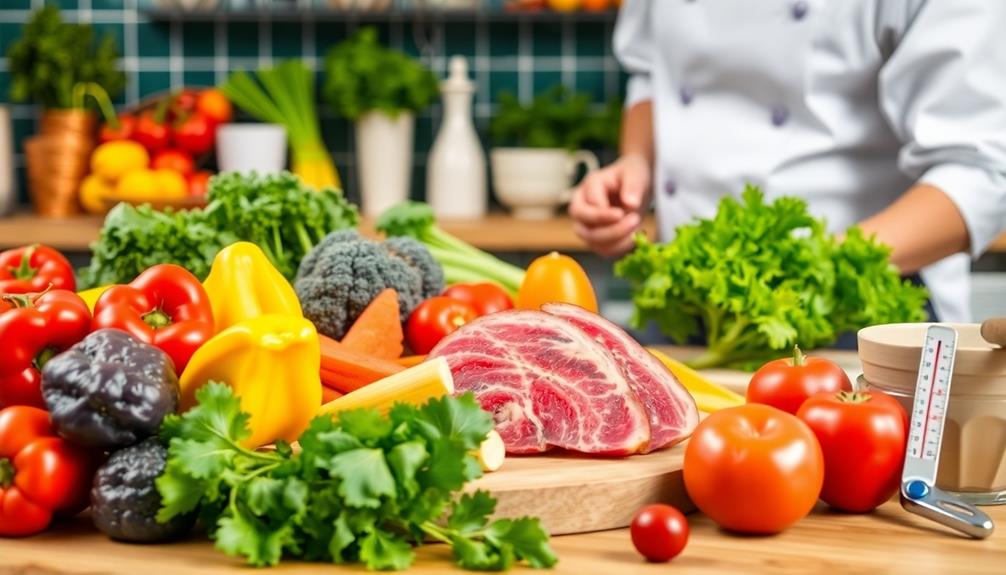Transporting raw food requires careful attention to safety. Start by keeping your raw perishables below 41°F (5°C) to slow bacterial growth. Use airtight containers to avoid cross-contamination, and separate cutting boards for raw meats and ready-to-eat foods. Keep ice packs handy to maintain safe temperatures during transit. Remember to log temperatures regularly and check for any deviations. Always wash your hands before and after handling raw items, and change gloves frequently. These practices will help guarantee food safety and protect consumers. There's more to learn about maintaining safety and quality throughout your transport process.
Key Takeaways
- Maintain raw foods at temperatures below 4°C (39°F) to prevent spoilage and foodborne illnesses during transport.
- Use separate, sanitized cutting boards and utensils for raw meat to minimize cross-contamination.
- Package raw perishables in airtight containers and waterproof bags to avoid exposure to contaminants.
- Employ advanced temperature monitoring systems to track and log temperatures throughout the delivery process.
- Ensure proper hygiene practices, including handwashing and glove usage, are followed by all food handlers.
Understanding Raw Food Risks
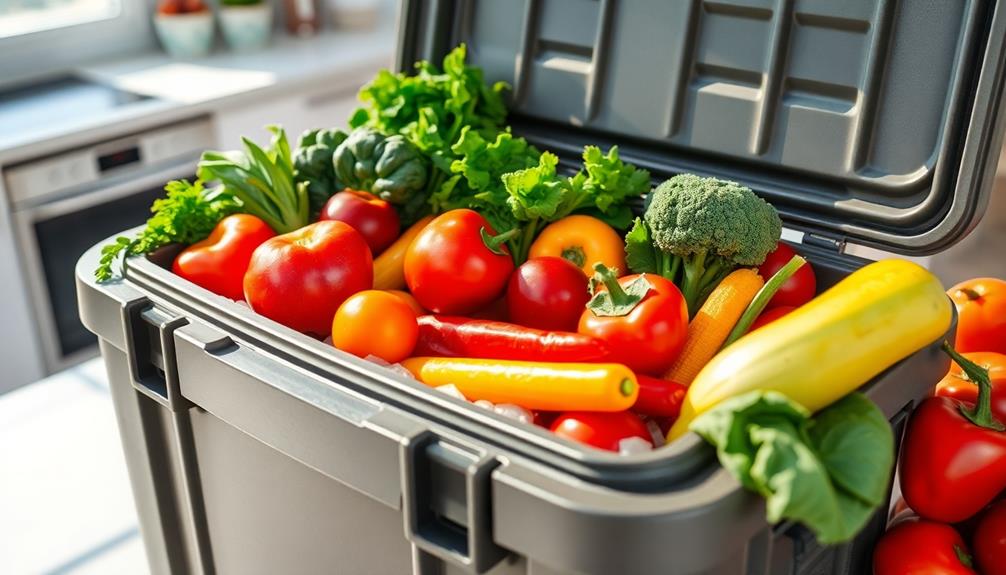
When it comes to handling raw food, understanding the associated risks is essential for your safety and health. Raw foods, especially raw meat, can harbor harmful bacteria like salmonella, E. coli, and listeria, which lead to foodborne illnesses. These illnesses can have severe health consequences, including hospitalization and even death.
When you're transporting food, cross-contamination is a considerable risk. If raw meat comes into contact with ready-to-eat foods, harmful bacteria can easily transfer, increasing your chances of illness. The Centers for Disease Control and Prevention (CDC) reports that around 48 million Americans get sick from foodborne illnesses each year, with raw foods being a primary contributor.
To minimize these risks, you need to follow some safety tips. First, always maintain proper refrigeration for raw foods, keeping temperatures below 41°F (5°C) to inhibit bacterial growth.
Additionally, make sure that raw food is tightly sealed and stored separately from other items to prevent contamination. By being aware of these risks and taking precautions, you can greatly reduce the likelihood of foodborne illnesses and make for a safer experience in handling raw food.
Essential Hygiene Practices
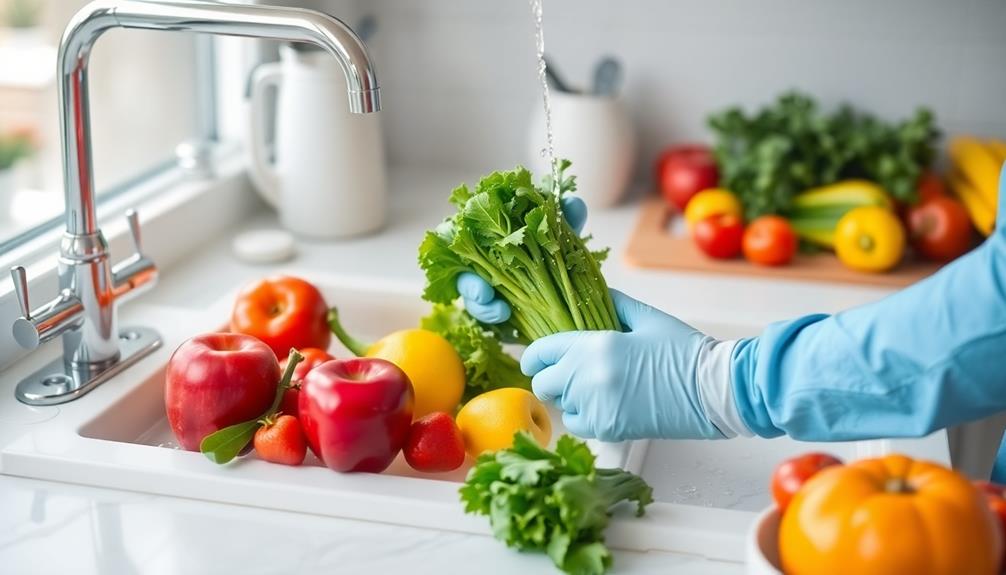
To guarantee food safety while handling raw meats, practicing essential hygiene is essential. Always wash your hands with warm, soapy water for at least 20 seconds before and after handling raw meat. This simple step helps prevent the spread of harmful bacteria like salmonella and E. coli.
Use separate cutting boards and utensils for raw meat and ready-to-eat foods to minimize cross-contamination, making sure that your meals remain safe.
Regularly clean and sanitize all surfaces and equipment that come into contact with raw meat, including countertops and knives. This will eliminate any lingering pathogens.
When handling raw meat, wear gloves and change them frequently to prevent transferring bacteria to other foods or surfaces.
It's imperative that all food handlers receive proper training on hygiene practices. Emphasize the importance of cleanliness and adherence to food safety protocols.
By implementing these hygiene practices, you'll greatly reduce the risk of foodborne illnesses and guarantee a safer environment for everyone involved in food preparation.
Safe Packaging Techniques

Proper packaging techniques are fundamental for guaranteeing the safety and quality of raw foods during transportation. Start by using airtight containers to package your raw perishables, as this prevents exposure to contaminants and keeps them fresh.
For raw meat, wrap it in butcher paper or vacuum-seal it to maintain its frozen state, which helps prevent bacterial growth.
Utilizing waterproof bags or containers is essential for transporting raw food items; this will help avoid leakage and prevent cross-contamination with other food products.
Don't forget to pack your raw perishables with ice packs or gel packs to maintain temperatures below 4°C, which minimizes the risk of spoilage during transport.
It's also important to clearly label all packages containing raw foods. This guarantees proper handling and avoids confusion with ready-to-eat items.
By following these safe packaging techniques, you can enhance food safety and ensure that your raw foods arrive in ideal condition.
Always invest in appropriate transportation equipment to support these methods, as it plays a critical role in preserving the integrity of your food.
Temperature Control Measures
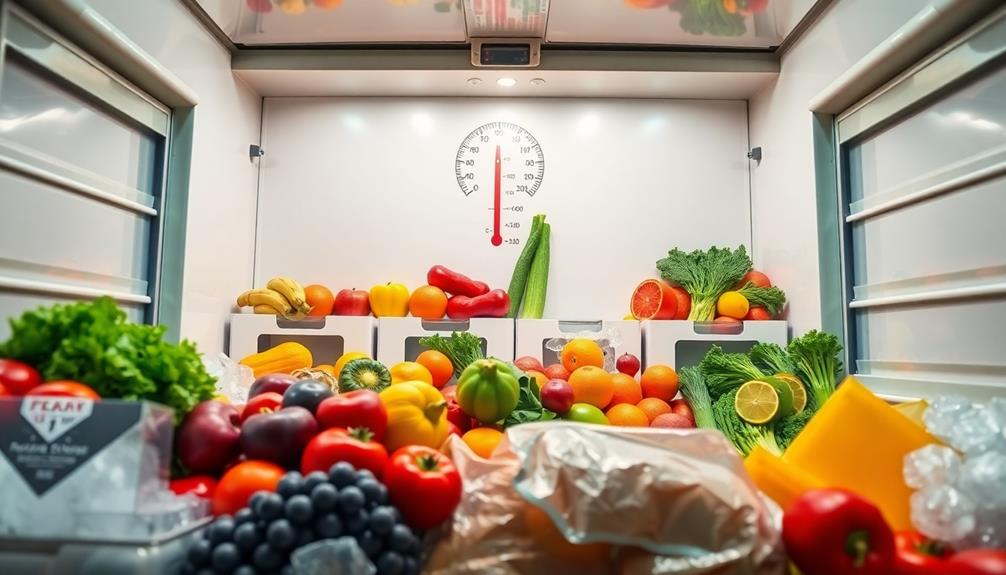
Consistently maintaining the right temperatures during transportation is essential for guaranteeing the safety and quality of raw foods. With perishable food, even slight temperature deviations can lead to spoilage or foodborne illnesses. Here are some key temperature ranges you should keep in mind:
| Food Type | Ideal Temperature Range |
|---|---|
| Deep-frozen seafood/meat | -28°C to -30°C (-18°F to -32°F) |
| Frozen meat/produce | -16°C to -20°C (3°F to -4°F) |
| Chilled fruits/vegetables | 2°C to 4°C (36°F to 39°F) |
Implementing real-time temperature monitoring systems is imperative. These systems help you track conditions during transport and guarantee compliance with food safety regulations. Rapid response to any temperature deviations is crucial; improper storage can foster dangerous bacteria growth, leading to serious health risks. By adhering to these temperature control measures, you can effectively mitigate risks associated with transporting raw foods, ensuring both quality and safety throughout the transportation process.
Guidelines for Perishable Foods
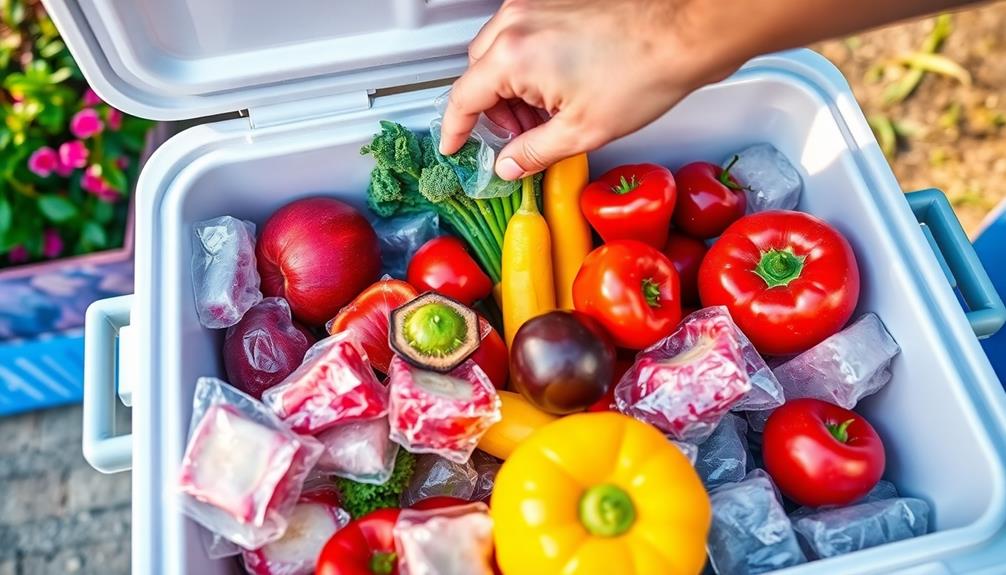
When transporting perishable foods, it's important to keep them at temperatures below 4°C (39°F) to prevent spoilage and foodborne illnesses. This includes items like dairy, eggs, and ready-to-eat foods, which require strict temperature control.
Use sealed containers and proper packaging to protect these perishables from contamination and spoilage during transit.
For fresh fruits and vegetables, you can safely transport them at room temperature for short trips. However, once you arrive, refrigerate them immediately to maintain their quality.
It's vital to implement temperature monitoring systems to check that all perishables have remained within safe ranges during transport.
Upon arrival, follow immediate transfer protocols to refrigeration to minimize the risk of temperature abuse. This quick action helps guarantee that your perishable items stay fresh and safe for consumption.
Remember, food safety is paramount, and attention to these guidelines will help you avoid any potential health risks associated with improperly handled perishables.
Always prioritize the condition of your food during transportation to make sure it reaches its destination safely.
Best Practices for Delivery
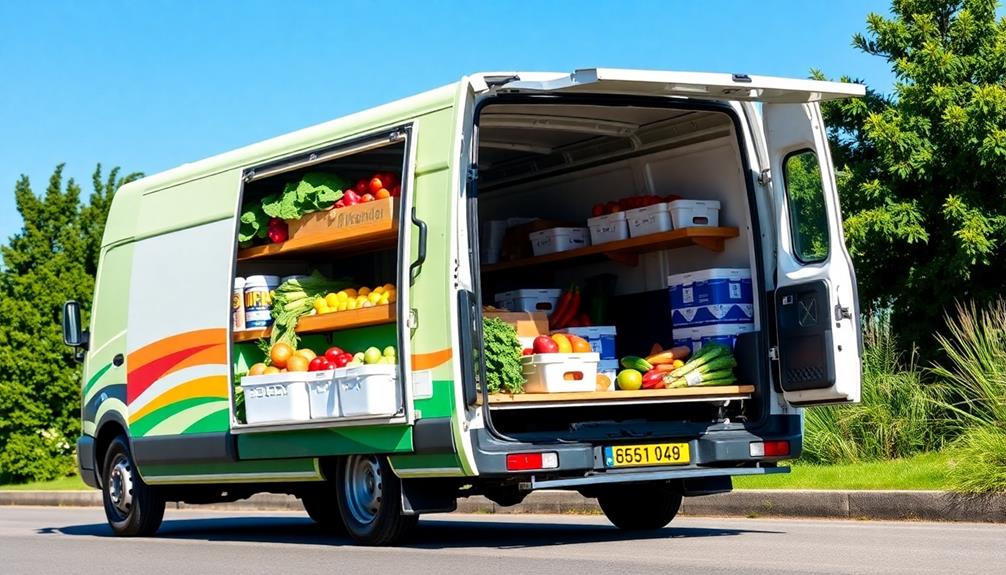
When it comes to delivering raw food, keeping track of temperature is essential.
You should use temperature monitoring techniques that alert you to any deviations during transport to guarantee food safety.
Additionally, proper packaging methods can help maintain the right conditions and prevent spoilage.
Temperature Monitoring Techniques
To guarantee safe delivery of raw food, effective temperature monitoring techniques are essential. Start by utilizing advanced temperature monitoring systems that provide real-time data. This guarantees you transport food within the required temperature ranges, like keeping frozen products at -18°C (0°F) or lower.
Implement a logging system to record temperatures at regular intervals throughout the delivery process. This practice not only guarantees compliance with food safety standards but also facilitates traceability in case of any temperature deviations.
In addition to monitoring, use insulated packaging and refrigeration units equipped with alarms. These alarms notify drivers of any temperature fluctuations that could compromise food safety during transport.
Regularly calibrate your temperature monitoring devices to maintain accuracy, as even slight deviations can lead to spoilage and increase risks of foodborne illnesses.
Lastly, train your staff on the importance of temperature control and the specific monitoring techniques required for different food types. Guarantee they understand how to respond quickly to any temperature-related issues during delivery.
Proper Packaging Methods
Proper packaging is vital for maintaining the safety and quality of raw food during delivery. To guarantee food safety, use insulated packaging that keeps frozen meat at temperatures between -16°C to -20°C (3°F to -4°F) and chilled products between 2°C to 4°C (36°F to 39°F).
When transporting foods, sealing raw items in airtight containers mitigates cross-contamination risks and preserves freshness. For instance, wrap raw meat in butcher paper or vacuum-seal it tightly.
Opt for eco-friendly and leak-proof packaging materials to minimize environmental impact while maintaining the integrity of your food shipments.
It's also important to clearly label all packages with handling instructions and contents, so everyone involved can ascertain proper handling and compliance during transportation.
Additionally, utilizing temperature monitoring devices within your packaging helps you continuously track and record temperature conditions, assuring that food products remain within safe ranges throughout their journey.
Monitoring and Documentation
When transporting raw food, you need to keep an accurate temperature log to guarantee everything stays safe and compliant.
Documenting each delivery not only meets food safety regulations but also helps maintain accountability throughout the process.
Temperature Log Maintenance
Regularly maintaining a temperature log during transportation is essential for guaranteeing the safety of perishable food items. By consistently monitoring temperatures, you can guarantee that food remains within required temperature ranges, preventing spoilage and safety hazards.
Here are three key practices to enhance your temperature log maintenance:
- Interval Checks: Document temperatures every 30 minutes. This frequency helps catch any deviations that could compromise food safety, allowing for immediate corrective action.
- Utilize Technology: Consider implementing real-time monitoring technology. This enhances accuracy in your temperature logging and provides instant alerts for any fluctuations, keeping you informed throughout the journey.
- Proper Documentation: Guarantee all temperature logs are meticulously recorded. This not only supports compliance with food safety regulations, such as those set by the FDA and CFIA, but also aids in traceability during inspections or in case of foodborne illness outbreaks.
Documentation for Compliance
Effective documentation is essential for guaranteeing compliance with food safety standards during transportation. You need accurate documentation to prevent foodborne illnesses and maintain consumer trust. Important documents include driver logs, shipping and receiving details, and temperature monitoring records. These documents help guarantee that food products are traceable and accountable throughout their journey.
Regulations can vary by country, so it's important to stay informed about specific documentation requirements to avoid delays and guarantee safe transit. Mislabeled or incomplete documentation can lead to spoilage, contamination, or even legal issues, highlighting the significance of meticulous record-keeping.
Make it a point to regularly audit your documentation practices; this can help identify potential food safety issues and guarantee adherence to compliance standards within the food transportation industry.
Keep in mind that maintaining temperature monitoring records is essential. They provide proof that food products have been kept at the correct temperatures, reducing the risk of foodborne illnesses.
Frequently Asked Questions
How Do You Transport Raw Food?
To transport raw food, keep it chilled below 41°F, use leak-proof containers, and separate it from ready-to-eat items. Monitor temperatures regularly and consider using refrigerated vehicles for safe and effective transport.
What Is the Proper Method for Transporting Food?
When you transport food, use insulated containers to maintain temperature, separate different types to avoid contamination, monitor temperatures, seal items in airtight containers, and keep your vehicle clean to guarantee safety and freshness.
What Are the 5 Food Safety Tips?
When ensuring food safety, remember these five tips: keep food at safe temperatures, avoid cross-contamination, maintain cleanliness, seal containers properly, and monitor temperatures regularly. Your vigilance can prevent foodborne illnesses and keep everyone safe.
What Are the 4 Safety Rules for Keeping Food Safe?
To keep food safe, you should wash hands and surfaces, separate raw and cooked foods, cook meats to safe temperatures, and chill perishables promptly. Following these rules helps prevent foodborne illnesses and guarantees safety.
Conclusion
By following these raw food transportation safety tips, you can greatly reduce the risk of foodborne illnesses. Did you know that about 48 million Americans get sick from foodborne pathogens each year? That's 1 in 6 people! By prioritizing hygiene, proper packaging, and temperature control, you not only protect your food but also the health of those consuming it. So, make safety your top priority, and guarantee your raw food reaches its destination safely and fresh.

